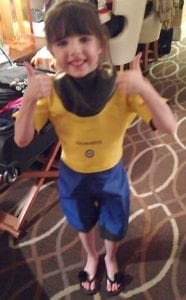We had never heard of pulmonary hypertension until December 2014. Now we know that it happens when the blood flow that leaves the right side of the heart faces an increased resistance, increasing pressure on that side of the heart.
Our introduction to pulmonary hypertension
Our first introduction to the condition happened when our daughter, Riley, was four years old. She started getting out of breath when she was running and swimming, two things she loves. We weren’t overly concerned, but decided to schedule an appointment with her cardiologist in our hometown of Lexington, KY.
She had previously seen a cardiologist because when she was 15 months old, her pediatrician heard a heart murmur. We saw a local cardiologist and found out that she had pulmonary insufficiency. This means that she has thickening of the pulmonary valve. The cardiologist wasn’t too worried about at the moment, but mentioned that if she started to get out of breath or faint, to bring her back in for an evaluation.
A life-altering Diagnosis
So fast-forward to December of 2014, when she started getting out of breath. We took her back to that same cardiologist in Lexington, KY, and our world turned upside down. She had an echocardiogram and the cardiologist diagnosed her with pulmonary hypertension six days before Christmas. To go from having a “typical” child to one with a life-threatening condition was life altering for us.
The frightening thing about pulmonary hypertension is that if it goes undiagnosed and untreated, the pressures will continue to rise. This could potentially cause right ventricular failure, arrhythmias, and even sudden death (in the most extreme cases). We feel incredibly fortunate that we avoided this situation.
Riley was referred to Cincinnati Children’s, where she had her first heart catheterization. Dr. Hirsch was shocked that she hadn’t passed out or had blue lips, given her high pressure levels.
Riley’s Treatment Regimen
We are now coming up on three years since her diagnosis and she is doing well. It’s comforting to know that she’s on a treatment regimen that is keeping her heart safe. She takes three daily medications: Revatio, Tracleer, and continuous intravenous Remodulin. It took some trial and error to find the right mix of medications, but we’re now on the right path. These three medications together help keep her heart pressures as stable as possible. And we visit Dr. Hirsch every three months for an EKG and echocardiogram and once a year for heart catheterizations. This ensures that there haven’t been any changes to her heart.
Most importantly, she is back to normal life with a few modifications. She has to avoid competitive sports and over-exertion. And her IV site needs to stay dry at all times. So showering is a little interesting and swimming requires a special “dry” suit.
Pulmonary Hypertension Often Misdiagnosed
It took Riley about two and a half years to get diagnosed. I’ve since learned that’s pretty typical for kiddos with pulmonary hypertension. It’s often misdiagnosed as asthma, COPD (chronic obstructive pulmonary disease) or sleep apnea.
This is why I’m sharing her story. If we hadn’t gotten her to the cardiologist, she might not have made it to her seventh birthday. She didn’t look sick. She was simply out of breath.

If your child is having symptoms, such as shortness of breath, fatigue, weakness, fainting, dizziness, and not getting better after treatment, trust your instincts. Push a little harder for further investigation.
Help Us Further Awareness
Please share this post with your friends and families so that more people are aware of pulmonary hypertension. The good news is that once diagnosed, it is a manageable condition with the right medical interventions. And in Riley’s case, we have learned to adapt so that she can still do the things that she loves (while wearing her dry suit, of course). Cannon ball!
To learn more about our pulmonary hypertension clinic at Cincinnati Children’s Heart Institute, please call 513-636-7072.



Dear MS.Wiegele,
I would like to know which dry suit Riley uses to swim with Remodulin.
Thank you,
Antonella